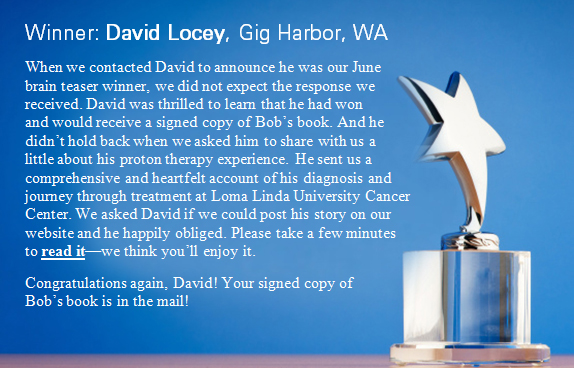.jpg)
.jpg)
Dear Members:
We have a number of celebrities in our group including professional sports figures, well-known business leaders, entertainers, radio and TV personalities, a former member of Congress, high-profile medical professionals, ambassadors, senior clergy members, and a high ranking member of the United Nations.
However, one of the most famous members of our group is probably a retired electrician who worked for Pacific Gas and Electric. His name is Bob Reimer.
Bob is the go-to guy when someone calls or emails us and says he is frightened because he was diagnosed with prostate cancer and has a high PSA and/or Gleason score. We typically give these men Bob Reimer’s phone number. A talk with Bob always settles them down. He has spoken with literally hundreds of recently diagnosed men.
Seventeen years ago, with a PSA of 61 and a Gleason score of 10, Bob’s urologist told him, “You had better get your affairs in order, because you have only a few months to live.” Bob was devastated to hear this news, but he refused to give up. He did his homework, discovered Loma Linda University Cancer Center and had proton therapy. And the rest, as they say, is history.
Bob Reimer is one of more than 200 men on our various proton patient reference lists. These volunteers have made a huge difference in people’s lives. Speaking with someone who has been through treatment is the best way to learn the “real story” about any treatment option and, maybe more important, life after treatment.
Both Deb and I spoke with Bob Reimer this month. He’s doing great and he’s enjoying life to the fullest. You will have a chance to meet Bob at the 25th anniversary celebration of the James M. Slater, MD Proton Treatment and Research Center at Loma Linda later this year. Deb and I, plus hundreds of BOB members, will be in attendance. Some details of the event are in this month’s BOB Tales.
Once again we have a newsletter packed with information about prostate cancer, proton therapy, and related subjects along with helpful information on health, wellness, and other topics of interest, including our new website. See highlights below.
As always, we welcome your feedback and suggestions for future newsletters. Just send an email to [email protected].
Bob Marckini
To print the BOB Tales newsletter or view the newsletter with a larger font size, click here for the PDF file.
Membership:
We have more than 8,000 members from all U.S. states and 39 countries. Members represent all operating proton centers in the U.S. as well as four proton centers in Europe and Asia.
In this Issue:
- New research shows benefits of proton therapy for cancer care
- Mayo Clinic Q&A on proton therapy
- Clinical trial: Can diet control prostate cancer?
- Several new proton centers announced. One state will have four!
- Loma Linda announces 25th anniversary proton center celebration
- High Gleason score members pay it forward
- Aspirin can reduce gastro cancer risk
- Ten myths about skin cancer
- Find out how long you will live
- Watermelon: Reasons to love this fruit
- New BOB website
.jpg)
New Research Shows Benefits of Proton Therapy for Cancer Care
It is estimated that more than half of cancer patients today will receive some form of radiation therapy as part of their treatment. And with survivorship rates steadily rising, physicians are increasingly aware of the need to avoid exposing patients’ healthy tissue to radiation, which can raise the probability of treatment-related side effects and secondary cancers.
Finding more precise ways to deliver radiation therapy was the focus of the 54th annual Particle Therapy Co-Operative Group (PTCOG) conference in May 2015. Experts from around the world gathered in San Diego to share insights on the latest advances in particle beam therapy, including proton therapy. The meeting was held in San Diego in part so attendees could tour Scripps Proton Therapy Center.
Below is a brief sampling of highlights from this year’s PTCOG conference that show how the field of proton therapy is improving cancer care for patients.
Melanoma of the Eye
A study led by researchers at the University of California, San Francisco randomized 184 patients with melanoma of the eye to receive either proton therapy or brachytherapy (the only two viable radiation options for this type of cancer, versus
the traditional option of surgically removing the eye). Twelve years after treatment, local tumor control for proton patients was 98 percent, compared to 79 percent for brachytherapy patients. And 83 percent of patients who received proton therapy preserved their vision 12 years following treatment, compared to 63 percent of those who underwent brachytherapy.
Esophageal Cancer
Researchers from the Mayo Clinic, University of Maryland, Baltimore and University of Texas MD Anderson Cancer Center compared outcomes of 582 esophageal cancer patients who underwent either proton therapy or X-ray (photon) therapy (in conjunction with chemotherapy and surgery). The retrospective analysis found proton patients experienced a lower rate of cardiac, pulmonary and gastrointestinal complications after surgery, compared to those receiving X-ray therapy. Average hospital length of stay was three days shorter for proton patients, compared to X-ray patients.
Breast Cancer
Two studies involving researchers at the Scripps Proton Therapy Center and University of California, San Diego demonstrated the effectiveness of proton therapy for accelerated partial breast irradiation. The first, a multi-institutional study, included 26 women who underwent proton therapy for two weeks (instead of the conventional six to seven weeks with X-rays). This study showed that the accelerated proton treatment is well tolerated, without excessive skin toxicity. The second study showed that using pencil-beam scanning enabled doctors to effectively deliver radiation with a single treatment field, which shortens treatment times for patients.
Pediatric Cancer
Because children’s bodies are still growing, pediatric cancer patients are especially prone to the late side effects of radiation exposure to normal tissue. A survey of all United States proton centers shows that the number of children treated with protons has grown to 722 in 2013, up from 465 in 2010. In 2013, 26 percent of pediatric proton patients were enrolled on multi-institutional registry studies. Patient outcomes data should help doctors optimize treatment approaches in the future.
Mayo Clinic Q&A on Proton Therapy
In a syndicated newspaper column the following question was asked of the Mayo Clinic:
“What does proton beam therapy do for cancer patients that standard radiation therapy doesn't do?"
The answer was quite long. Here are some excerpts:
“Proton beam therapy is a type of radiation therapy used to treat cancer. Unlike standard radiation therapy using X-rays, which travel all the way through a person’s body, protons go to the tumor, release their energy and stop. That means proton beam therapy tends to be more effective, and causes fewer side-effects, than standard radiation therapy.”
“Today’s standard radiation therapy uses high energy X-rays that travel though the body. Proton beam therapy is different. This treatment directs protons into a tumor, where their energy is released. Radiation oncologists can control the depth of penetration of the protons and where they release their energy by adjusting the energy of the protons.
The amount of radiation energy released as the proton is entering a person’s body is quite low. The majority of the energy released is in the last few millimeters of the protons’ path, so the largest amount of radiation energy is released directly within the tumor.
For example, consider a person who has a tumor located near the back of one lung. The standard X-ray beam aimed at the tumor from the back will travel through the tumor and exit through the normal lung and heart in front of the tumor. With proton beam therapy, protons are directed into the body from the back, but they stop in the tumor. That delivers radiation to the tumor, but none to the normal lung and heart in front of it.
Because much of the healthy organs surrounding the tumor do not receive radiation energy with proton beam therapy, side effects are less likely and less severe when compared to standard radiation therapy.
The radiation energy can also be more accurately and precisely controlled using proton beam therapy. That means the amount of radiation energy delivered to the tumor can often be safely increased, potentially increasing the treatment’s effectiveness and possibly decreasing the number of treatments needed by giving a higher dose with each treatment. This makes the treatment more convenient for the patient and less costly.
Proton beam therapy can be used for many kinds of tumors. It’s particularly useful in cancers located near critical organs that are sensitive to the effects of radiation. It’s also well-suited to treating tumors located deep within the body, when concern about damage to healthy organs and tissue may require that the standard radiation treatment dose be decreased.”

Save the Date: LLUCC’s 25th Anniversary Celebration and Patient Homecoming Event
The James M. Slater, MD Proton Treatment and Research Center invites you to celebrate the 25th anniversary of the proton center on Monday October 26, 2015. The event includes a special patient alumni homecoming commemoration with various on-campus events for patients and their families and friends including hikes, healthy relationship seminars, cancer-fighting foods demonstrations, and a screening of a proton patient documentary. The homecoming ceremony at the end of the day is going to be an amazing event for patients and families to celebrate the many lives changed with proton therapy as well as a look into the future of proton therapy. More information will follow.
Recap: BOB Reunion and Golf Event, Newberg/Portland, OR
Last month BOB member Gary Brown coordinated this event. “It was fantastic,” he told us. “Eleven guys joined the golf outing in Newberg—and one even got a ‘hole in one!’” The dinner, held at the Portland Adventist Medical Center and emceed by BOB member Elton Zerby and was attended by 50 BOB members, friends, and LLUCC staff including Dr. Lynn Martell who gave a presentation with a video about LLUH’s Vision 2020.
Reunion Attendees, Portland, OR:
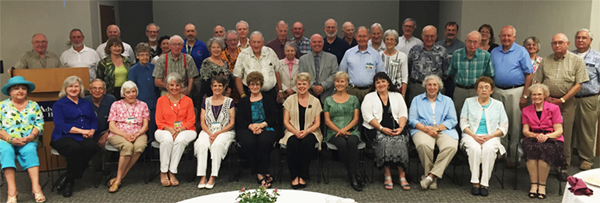
Recap: BOB Reunion, Fargo, ND
This reunion was held last month at the Spitfire Grill in West Fargo, owned by BOB member Lew Wilson, where they serve “food with attitude.” Twenty-two people attended (some drove four hours to attend!). Dr. Lynn Martell gave an update on proton therapy at LLUCC and an overview of Vision 2020. Billie Baker, LLUH Major Gifts Officer for the Children’s Hospital was also in attendance.
Reunion Attendees, Fargo, ND:
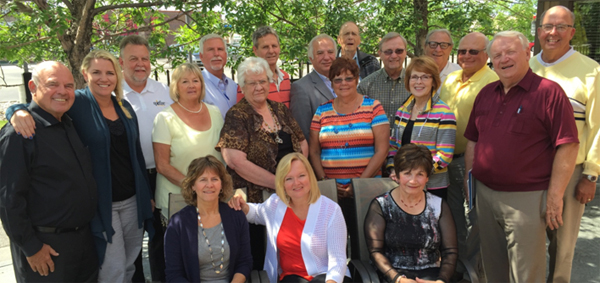

High Gleason Score Members Pay it Forward
Last month we received an inquiry from a recently diagnosed individual who had a high Gleason score. As you might expect, he was anxious and fearful; he was weighing all the treatment options; and he was particularly concerned about side effects. He not only wanted to speak with former patients—especially members with high Gleason scores—he wanted to speak with men who were treated within the past two years.
Since our “High Gleason Score Reference List” did not contain members treated within the past two years, Deb sorted through our member database and found many men who fell into this category. She sent each of them an email requesting their permission to be listed on our high Gleason score patient reference list. We explained how important our reference lists are; estimated how often they might be contacted by newly diagnosed men and/or their family members; and reiterated how fearful newly diagnosed men are and how important it is to hear from others who have been in their situation.
No Surprise: Overwhelming Response
Most who we contacted responded within 24 hours. All but one volunteered to be included on the reference list (one gentleman was simply “too busy” with his active life, but thanked us for being considered), volunteering to email or speak with this gentleman and others. Most were enthusiastic and felt it was their honor to pay it forward in such a way. It’s times like these when we feel proud to be connected with such fine people.
Getting to Know Our Members
These processes—searching our member list for various groups of men, usually as the result of a prospective proton patient’s inquiry—also open doors for members to connect/communicate with us on a deeper level. Charlie Martin (Palm Desert, Calif.) is a good example.
Not only did Charlie jump at the chance to be included on our high Gleason score reference list; he told us he felt “privileged to be considered.” He went on to explain how much he appreciated Bob Marckini’s book, calling it his personal “bible.”
Charlie told us, “Life is good and I will continue to practice architecture until I’m 120.” He shared a bit about his history: He toured Vietnam on a fact-finding tour as an Army airborne ranger; he owned and operated a commercial fishing boat in Alaska; and once, he destroyed a perfectly good Ducati 998 motorcycle (he “highsided it”).
When we asked about current hobbies, Charlie said he’s “too busy” designing an observatory for a local city in California to think about hobbies (!).
Note: Charlie humorously titled his email, “Gleason and I don’t mean Jackie.” We love getting to know our members and we love their upbeat attitudes. Our members are awesome!

The Healing Hands Team at LLUCC
A record number of staff at Loma Linda University Cancer Center's Proton Treatment and Research Center was recently recognized by the hospital’s “Healing Hands” program. This program is one way that grateful patients and their families can give a philanthropic gift in honor of a Loma Linda University Health physician or staff member who has made a difference in their lives. When a patient receives care at LLUH, he or she is often inspired to give back. From physicians and nurses, to the staff at the front desk, each team member often goes the extra mile to create an exceptional experience. Recently, an extraordinary experience at LLUH inspired a gift of $500,000 because of the excellent care a patient received.
Congrats to all the hardworking caregivers at the proton treatment center who were recognized!
LLUCC’s Healing Hands Recipients:

If you were treated at LLUCC and would like to honor one of your caregivers, please contact mailto:[email protected] or 909-558-4438. For more information on the Healing Hangs program, visit lluhealinghands.org.
How to Support Proton Research
Make a Future Gift:
Contact Todd Mekelburg at the Office of Planned Giving at Loma Linda University Health at 909-558-4553 or email [email protected].
Donate to the Marckini Chair:
- Send a check made out to “LLUCC Proton” to Loma Linda University Health, Office of Philanthropy, P.O. Box 2000, Loma Linda, CA 92354. Memo line: “Marckini Chair.”
- Donate online or call Elvia DeHaro at 909-558-5010.
Other Ways to Give:
Contact Matt Miller at the Office of Philanthropy at Loma Linda University Health at 909-558-3284 or email [email protected].

.jpg) Aspirin Can Reduce Gastro Cancer Risk
Aspirin Can Reduce Gastro Cancer Risk
A new study shows that regular aspirin use over the course of several years may reduce the risk of developing gastrointestinal cancers including
colon cancer.
According to the study’s lead researcher, Yin Cao at the Harvard University School of Public Health, there was a 20 percent lower risk of cancers of the gastrointestinal tract among regular aspirin users.
The results of the study were presented in March at an American Association for Cancer Research meeting in Philadelphia.
10 Myths about Skin Cancer
This is the time of year when most in the western hemisphere spend a lot of time outdoors. It’s an important time to learn the truth about the dangers of skin cancer. According to Spry Living there are many mistaken ideas about when sun can harm us and about protection from damaging sun radiation. The 10 common myths are:
1) Dark skin protects you from skin cancer.
“Anyone can get skin cancer, even the darkest skinned people,” says Dr. Darrell Rigel, clinical professor of dermatology at NYU Medical Center. “But the fairer you are, the greater the risk.”
2) A base layer of tan protects you from skin damage.
Tanned skin is damaged skin. “There is no such thing as a safe tan,” says Dr. Rigel.
3) Only the sun can cause skin cancer.
“Tanning beds emit UV light 15 times stronger than normal sun light. So they are even more dangerous.”
4) The higher the sun protection factor (SPF) in sunscreen, the safer your skin from UV rays.
“Yes and no,” says Dr. Rigel. SPF protects from UV-B rays, but not from UV-A rays believed to cause both burning and aging. Rigel feels you should choose “broad spectrum” sunscreen which blocks both A and B rays. Higher SPF ratings add a small amount of additional protection, but not that much.
5) Sunscreen is all you need to protect your skin.
Sunscreen is only one of several ways to protect your skin. Wear long sleeves and pants, a hat with a brim, and UV-light-blocking sunglasses.
6) Sunscreen chemicals are harmful.
“The amount of absorption is small,” says Rigel.
7) Age and skin cancer go hand in hand.
It is true that the older you are the greater your risk. “But Rigel says, “In the last 10 years, we’ve been seeing teens, especially young women with skin cancer. That’s probably due to tanning beds.”
8) You have no skin cancer risk in winter on cloudy days.
Whenever you are outdoors you get some exposure to UV rays.
9) Sun won’t harm you if you’re in a car.
UV-B rays don’t go through glass, but UV-A rays do.
10) Skin cancers aren’t deadly.
“Ten thousand Americans will die this year of melanoma,” says Rigel. “And if you don’t treat squamous skin cancer, you can die, although that’s rare.”
Want to know how long you will live?
Northwestern Mutual Life Insurance Company has designed a “Lifespan Calculator.” You are asked to answer 13 questions about height, weight, certain vital signs, stress and exercise level, diet, smoking history, and driving record. Each time you answer a question, your expected lifespan is recalculated. This tells you how certain lifestyle choices impact your longevity. There is nothing absolute in this calculator, but it is an interesting way to look at how we are living our lives.
It takes about three minutes. Why not give it a try?
Bob and Deb plugged in their information. Bob’s predicted lifespan is 96 years; Deb’s is 93 years. What is your predicted life span?
Series: Top 20 Most Common Health Questions
Last year, we began a series on the top 20 most common health questions (and answers) from Business Insider Magazine. Here is another question from that list.
Is bottled water better for you than tap water?
Short answer: No. Bottled water is no safer or purer than tap water, although it is substantially more expensive.
A recent study by Glasgow University in the U.K. found that bottled water is actually more likely to be contaminated than water from your faucet because it is less well-regulated.
Bottled water and tap water typically come from the same sources—natural springs, lakes, and aquifers. While public water supplies are tested for contaminants every day, makers of bottled water are only required to test for specific contaminants
every week, month, or year.
Watermelon: Reasons to Love this Fruit
According to Kevin Soden, MD, Family Medicine Sharecare Medical Advisor, there are lots of reasons to love the fruit he calls a “nutritional superstar.” He says watermelon helps keep your arteries clear; it reduces body fat; lowers bad cholesterol; cleans heart-threatening plaque from your arteries; drops your systolic blood pressure; and it helps boost blood circulation. Watermelon is also loaded with lycopene, which helps fend off heart disease and some cancers, including prostate cancer. In fact, watermelon has 40 percent more lycopene than tomatoes. And it’s low in calories—only 48 calories per cup.

Bob Marckini’s book, “You Can Beat Prostate Cancer And You Don’t Need Surgery To Do It,” is listed in the No. 3 position on a search for “prostate cancer” on Amazon.com (all departments) out of 44,562 search results at the time of this writing. Within the “books” department, the book is listed in the No. 3 position on a search for “prostate cancer” out of 30,011 search results.
The book has 224 reader reviews on Amazon—more than any other book in the top 50!
Here is an excerpt from what one reader recently had to say:

Every man needs to know about this! By Valerie
Good read. It’s nice to know about a non-surgical alternative for prostate cancer treatment. Because of the helpful information in this book, a loved one diagnosed with prostate cancer was able to make an informed decision on treatment. He chose proton therapy over surgery and is very happy with the results. His urologist never mentioned proton therapy as an option, so he fired him!
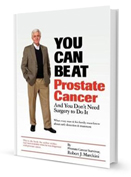 More Information / Where to Buy the Book:
More Information / Where to Buy the Book:
Paperback: $19.00--·--Kindle: $9.99--·--NOOK Book: $9.99--·--Apple iBook: $9.99
Proceeds from book sales help fund BOB efforts and support proton therapy research.
Ask about our bulk discount for paperback books: [email protected].
If you found Bob’s book helpful in making your proton treatment decision, please post a review on Amazon. Once you are logged into your Amazon account, click here and click “Create your own review” button. Don’t forget to rate the book from 1 to 5 stars!

Our New Website
We are pleased to announce the launch of our new website, designed with a fresh look and user-friendly navigation, updated with the latest information about proton therapy, our organization, and our members.
We realize it’s been a long time coming and there have been many bumps along the road. In fact, during the process Deb received hundreds of email messages from confused and frustrated members who couldn’t access the member database and/or had other problems using the site.
Why fix what’s not broken?
On the outside, it may have appeared that our website and member database were in fine, working order—so why take the time and energy (and aggravation) to modify them? Well, as they say, things are not always as they seem.
The need to update the website was long overdue. The old site was launched nearly 15 years ago using an old coding language. Because of this, every time we had to make even the smallest correction or update to the site, Deb had to download content, make changes in HTML language, upload, and then view the changes online for accuracy and formatting. Also, designing and uploading our monthly newsletter for the website took days.
Additionally, the member database was sluggish—it “crashed” weekly—sometimes daily—and we often had to seek outside IT help in order to correct the problems. Furthermore, new members were not getting signed up because the system was overloaded (Back in 2000 when Bob Marckini and some friends decided to stay in touch, humorously calling their group the “Brotherhood of the Balloon,” they never expected it would grow from a few men to 8,000!).
Also, existing members were having problems logging in to the database because of technical problems due to the sheer volume of member profiles and myriad pieces of information connected with each profile.
So, what may have seemed fine on the outside was, in fact, highly problematic on our end.
What’s changed?
The BOB website was transferred to a content management system, a web application designed to make it easy to add, edit, and manage a website. Not only do content management systems help with content editing, they also take care of a lot of “behind the scenes” work such as automatically generating navigation elements, making content searchable, and much more. Deb can now plug in or change content in literally under a minute (no coding necessary!).
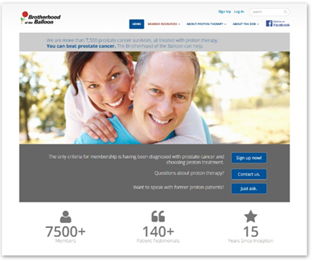 The member database can now easily handle thousands and thousands of pieces of information and though not directly searchable by members, the BOB team has the ability to quickly and easily locate information upon request. Members still have the ability to access their own profiles, and when logged in, they are able to access the newly enhanced Member Resources section, which includes archived BOB Tales newsletters, insurance appeal information, a list with names of urologists recommended by our members, and the BOB PowerPoint presentation with additional information and suggestions for use. And, more insider information is planned for this section. Keep checking back!
The member database can now easily handle thousands and thousands of pieces of information and though not directly searchable by members, the BOB team has the ability to quickly and easily locate information upon request. Members still have the ability to access their own profiles, and when logged in, they are able to access the newly enhanced Member Resources section, which includes archived BOB Tales newsletters, insurance appeal information, a list with names of urologists recommended by our members, and the BOB PowerPoint presentation with additional information and suggestions for use. And, more insider information is planned for this section. Keep checking back!
We hope you will enjoy our new site. If you have any questions, comments or suggestions please send them our way.
Special thanks to the Loma Linda University Health IT team for their help and support over the past several months on this project.
.jpg) BOB Member’s Wife Pens Book on Surviving Cancer
BOB Member’s Wife Pens Book on Surviving Cancer
Joanna Giangardella wasn’t facing any run-of-the-mill cancer. She was dealing with a rare and aggressive, stage 4 cancer. Her book, “Dancing Skeleton” documents her journey from early childhood, after being separated from her family in Greece, only to be adopted by a dysfunctional family in America. She relied on inner strength to survive, start a family, and grow a business.
Along the way came a devastating diagnosis with a treatment regimen that brought her near death. Mistakes and challenges by the medical profession complicated things even further.
Joanna faced the challenge of rediscovering her birth family and battling a deadly disease. She came out the other side a stronger person, committed to helping others fight their fears and find their way. Her book is a compelling story of hope and survival.
Did You Know?
- Africa is larger than China, India, Western Europe, Eastern Europe, Mexico, Japan, and the United States combined.
- There are about 450 billionaires in the United States. And about 200 of them live in New York and California.
- Switzerland is the best place to be born. According to the Economist’s Intelligence Unit, Switzerland gives its children the best chance of a happy, safe, and prosperous life. The measures used are wealth, crime levels, trust in public institutions, and health. Austria and Norway are close behind. The United States is tied with Germany for 16th place.

Last Month’s Brain Teaser
Forward I am heavy, but backward I am not. What am I?
Answer: Forward I am a TON; backward I am NOT.
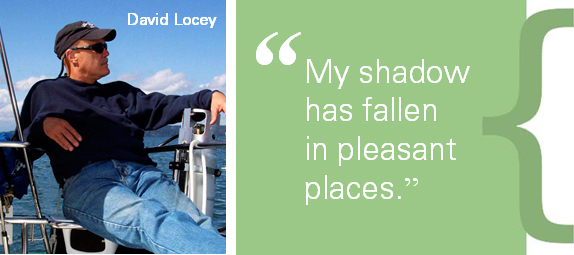
New Brain Teaser
How many patients, worldwide, have been treated with proton therapy?
Whoever comes closest to the correct answer will receive a signed copy of Bob’s book and a BOB T-shirt (size large) courtesy of BOB member, Bob Hawley.
Answer next month: Send your brain teaser answers to [email protected].
Having a Bad Day?
If you are having a bad day, remember that in 1976, Ronald Wayne sold his 10 percent stake in Apple for $800. Now that 10 percent stake is worth more than $58 Billion. Oops!
Phyllis Diller-isms:
- Whatever you may look like, marry a man your own age. As beauty fades, so will his eyesight.
- Housework can't kill you, but why take a chance?
- Cleaning your house while your kids are still growing up is like shoveling a sidewalk before it stops snowing.
- The reason women don't play football is because 11 of them would never wear the same outfit in public.
- The best way to get rid of kitchen odors? Eat out.
- You know you're old when they have discontinued your blood type.
Quote of the Month:
‘Those who are happiest are those who do the most for others.’ ―Booker T. Washington

The Empty Pickle Jar
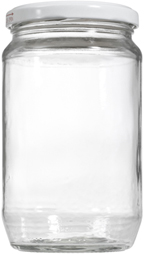 A professor stood before his philosophy class and had some items in front of him. When the class began, wordlessly he picked up a very large and empty pickle jar and proceeded to fill it with golf balls.
A professor stood before his philosophy class and had some items in front of him. When the class began, wordlessly he picked up a very large and empty pickle jar and proceeded to fill it with golf balls.
He then asked the students if the jar was full. They agreed that it was. So the professor then picked up a box of pebbles and poured them into the jar. He shook the jar lightly. The pebbles rolled into the open areas between the golf balls. He then asked the students again if the jar was full. They agreed it was.
The professor next picked up a box of sand and poured it into the jar. Of course, the sand filled up everything else. He asked once more if the jar was full. The students responded with a unanimous “yes.”
The professor then produced two glasses of chocolate milk from under the table and poured the entire contents into the jar effectively filling the empty space between the sand.
The students laughed.
The Moral of the Story
The professor waited for the laughter to subside.
“Now,” said the professor, “I want you to recognize that this jar represents your life. The golf balls are the important things—your faith, your family, your children, your health, your friends, your favorite passions. Things that if everything else was lost and only they remained, your life would still be full.”
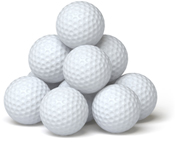 “The pebbles are the other things that matter like your job, your home, your car.”
“The pebbles are the other things that matter like your job, your home, your car.”
“The sand is everything else…The small stuff. If you put the sand into the jar first, there is no room for the pebbles or the golf balls. The same goes for life. If you spend all your time and energy on the small stuff, you will never have room for the things that are critical to your happiness.”
“Play with your children. Take time to get medical checkups. Take your partner to dinner. Play another 18. There will always be time to clean the house or fix the disposal.”
“Take care of the golf balls first, the things that really matter. Set your priorities, the rest is just sand.”
Low PSAs to all,
Bob Marckini and Deb Hickey
To print the BOB Tales newsletter or view the newsletter with a larger font size, click here for the PDF file.
NO MEDICAL ADVICE: Material appearing here represents opinions offered by non-medically-trained laypersons. Comments shown here should NEVER be interpreted as specific medical advice and must be used only as background information when consulting with a qualified medical professional.


